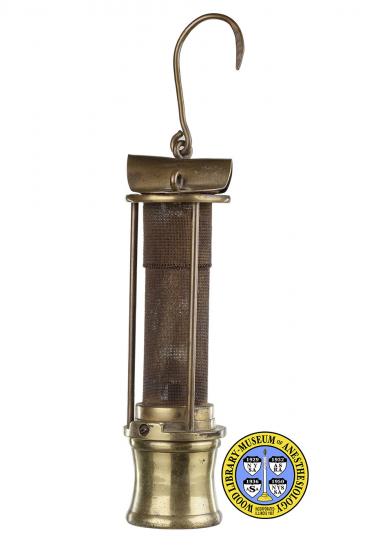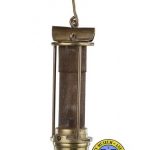Davy Lamp
The British chemist, Sir Humphry Davy (1778-1829) developed his safety lamp for miners around 1815. It employs his discovery that wire mesh can disseminate heat rapidly enough to prevent a candle’s heat from igniting methane gas. The flame would turn bluer and brighter around methane, and would dim or extinguish around too little oxygen. Davy did not patent his lamp, and its use in mines began in 1816. For this invention the Royal Society awarded him the Rumford Medal that same year. A few years later, he was made a Baronet for his services to industry.
The Davy lamp gave miners a way to detect dangerously low levels of oxygen, and reduced the possibility of explosions, saving an incalculable number of lives. But these advantages allowed mine operators to send their workers into places where they could never have gone before due to high concentrations of methane. Tragically, this caused many to die of suffocation.
Davy became President of the Royal Society in 1820. His other contributions to science include the study of nitrous oxide gas, and the first suggestion that it could be used to relieve the pain of surgery. He also discovered the elements, chlorine and iodine. In 1869 the Royal Society established the Davy Medal in his honor.
Catalog Record: Davy Lamp
Access Key: akvs
Accession No.: 2006-10-10-1 C
Title: [Davy miners safety lamp.]
Author: Davy, Humphry, Sir, 1778-1829.
Corporate Author: American Safety Lamp and Mine Supply Company.
Title variation: Alt Title
Title: Davy lamp.
Title variation: Alt Title
Title: Davy style safety lamp.
Title variation: Alt Title
Title: Miner’s safety lamp.
Publisher: [Scranton, PA]: A.S.L. & M.S. Co., [1893-1930].
Physical Descript 1 lamp : brass, other metals ; 23.5 x 7 x 11 cm.
Subject: Davy, Humphry, Sir, 1778-1829.
Subject: Explosions – prevention and control.
Note Type: General
Notes: Davy-style miner’s safety lamps have a number of common names, as reflected
in the alternate titles taken from American mining literature of the late
1800s and early 1900s. The title is taken from the WLM museum’s common name
for the object.
Note Type: General
Notes: The early date in the date range for the possible year of manufacture is
based on the year that the manufacturer was formed in Scranton, Pennsylvania:
March 8, 1893. The end-year is a generous estimate. A number of improvements
had been made in lamp design by 1920. A lamp with no globe (glass) or shield
(bonnet) or other advancements (double-gauze, easy ‘re-lighter’, or locking
device) is not likely to have been made after 1930.
Note Type: General
Notes: The National Museum of American History has a photograph of a very similar
lamp on their online exhibit at https://americanhistory.si.
edu/collections/search/object/nmah_872269.
Note Type: Citation
Notes: Humphry Davy. Chemical Heritage Foundation website. https://www.chemheritage.
org/discover/online-resources/chemistry-in-history/themes/electrochemistry/da
y.aspx. Accessed September 14, 2014.
Note Type: Citation
Notes: Mining lights and hats: safety lamps. National Museum of American History
website. https://americanhistory.si.
edu/collections/object-groups/mining-lights-and-hats?ogmt_page=miners-safety-
amps. Accessed August 20, 2014. [First sentence of the last paragraph:
“Safety lamps were manufactured by a variety of companies from around 1815
until the 1930s, and incorporated elements of their design from Clanny,
Stephenson, and Davy.”]
Note Type: Citation
Notes: Riegels N1, Richards MJ. Humphry Davy: his life, works, and contribution to
anesthesiology. Anesthesiology. 2011;114(6):1282-1288. https://journals.lww.
com/anesthesiology/Fulltext/2011/06000/Humphry_Davy__His_Life,_Works,
_and_Contribution_to.13.aspx. Accessed September 14, 2014.
Note Type: Citation
Notes: Sir Humphry Davy (1778-1829). BBC History website. https://www.bbc.co.
uk/history/historic_figures/davy_humphrey.shtml, Accessed September 14, 2014.
Note Type: Physical Description
Notes: One Davy-style miners safety lamp made of brass and other metals; The
measurements in the physical description field were taken facing the side of
the hood with the manufacturer’s mark on it, and with the hook laying toward
the back of the lamp; The height of the lamp, including hook, when suspended
by the hook is approximately 23 cm.; The lamp sits on a circular base, or
font, that holds the illuminant (oil) and wick; The base has some scratches
and signs of age; Being a Davy-style lamp, it is without a glass globe or
shield; A single layer of metal gauze is ‘capped’ by a second gauze over its
upper portion; The two pieces are connected by a horizontal strand of woven
metal; The gauze is rusted; Under the brass hood is a circular piece of metal
gauze; The hood is supported, and connected to the base, by three metal rods
or ‘standards’; Stamped or engrave onto once side of the hood is the
manufacturer’s mark, “A S.L.&M.S. CO.”.
Note Type: Reproduction
Notes: Photographed by Mr. Steve Donisch, September 16, 2013, with a miners safety
lamp made by Koehler, SydneyPlus Key akvt.
Note Type: Historical
Notes: The British chemist who first suggested that nitrous oxide might be used to
mitigate the pain of surgery also invented a well known lamp for coal miners.
The chemist was Humphry Davy (1778-1829). His 1799 recommendation to use
nitrous oxide during surgery went unnoticed, but his other insights on
nitrous oxide brought him significant opportunities and a certain amount of
fame.
Davy invented the miners lamp in 1815 in response to deadly mine explosions.
Coal miners used oil lamps to see in mine tunnels. Methane gas easily
accumulated in the tunnels, which were poorly ventilated. Explosions often
occurred when methane caught fire from the flame of a lamp, lighting coal
dust and coal as well. Davy discovered that if a flame was surrounded by a
thin iron mesh the light would radiate from the lamp but the high heat of the
flame could not spread beyond the mesh to trigger an explosion. Eventually
new lamps were introduced that incorporated Davy’s iron mesh with the best
designs of other inventors.
Humphry Davy also discovered the elements potassium, sodium, magnesium,
calcium, strontium and barium, invented the field of electrochemistry, and
wrote the first text on the application of chemistry to agriculture. He was
knighted in 1812, and became president of the Royal Society of London in 1820
The engraving on the hood, “A.S.L.& M.S.CO.” is likely from a previous owner,
the American Safety Lamp & Mining Supply Co.
Note Type: Publication
Notes: Bergman NA. Humphry Davy’s contribution to the introduction of anesthesia: a
new perspective. Perspect Biol Med. Summer, 1991;34(4):534-541.
Note Type: Publication
Notes: Jacob MC1, Sauter MJ. Why did Humphry Davy and associates not pursue the
pain-alleviating effects of nitrous oxide? J Hist Med Allied Sci.
2002;57(2):161-176.
Note Type: Publication
Notes: Jay M. The atmosphere of heaven: the 1799 nitrous oxide researches
reconsidered. Notes Rec R Soc Lond. 2009;63(3):297-309. https://rsnr.
royalsocietypublishing.org/content/63/3/297.long. Accessed September 14, 2014
Note Type: Exhibition
Notes: Selected for the WLM website; Previously on display in the Park Ridge
Building in a ‘Davy’ Exhibit.


